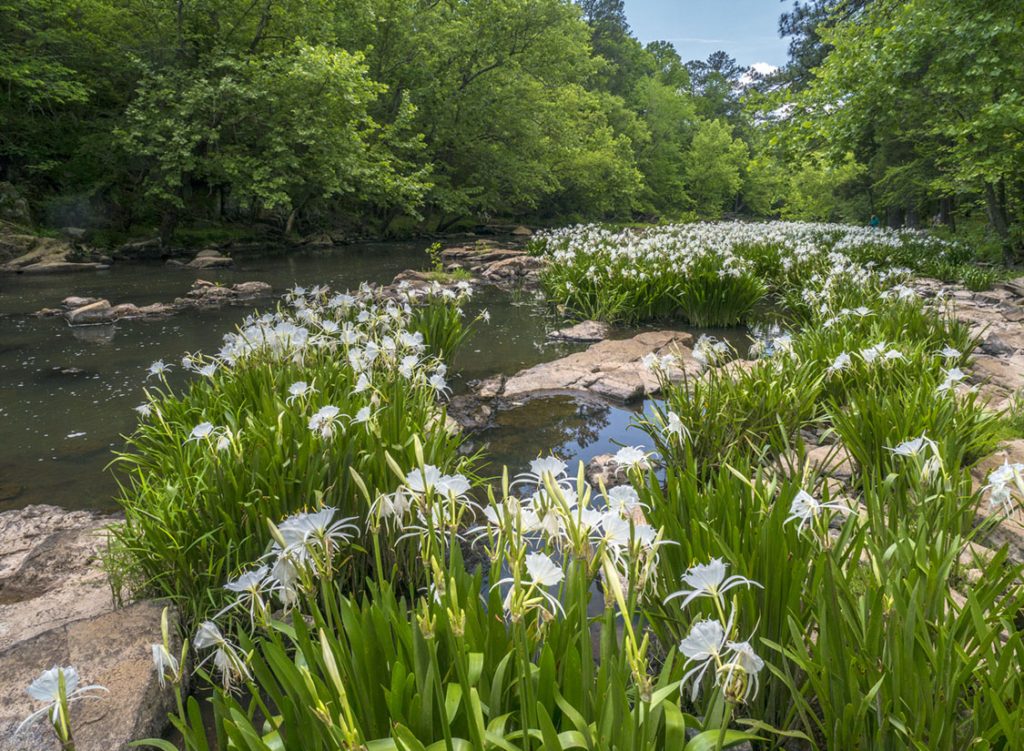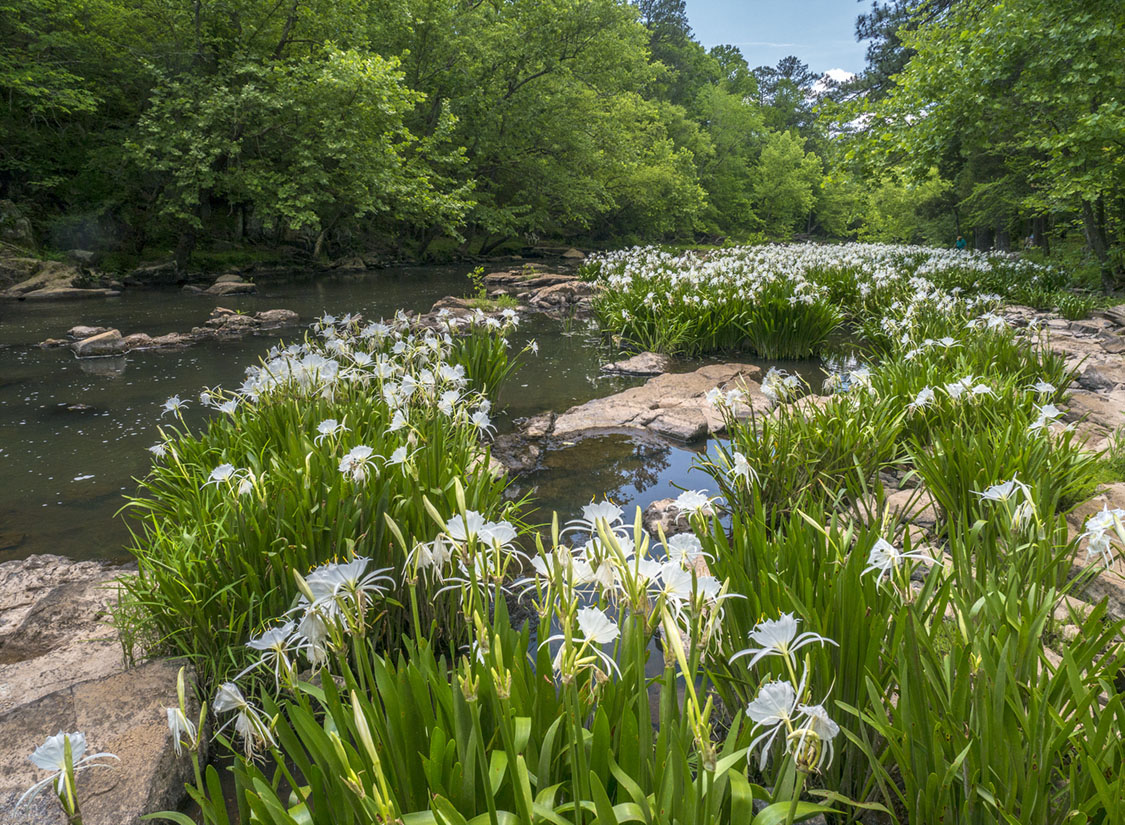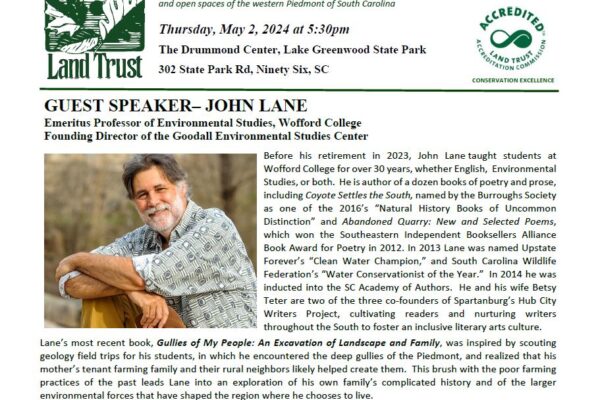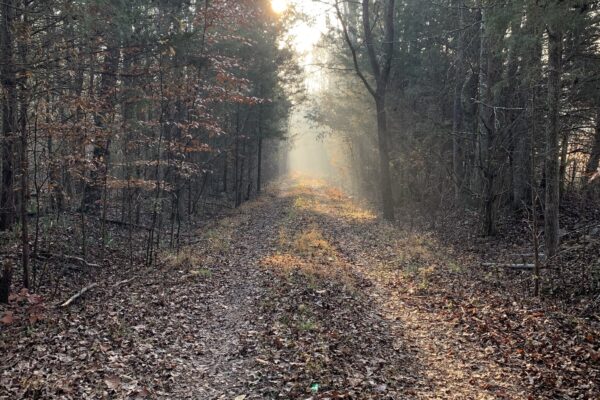SC Native Plant Society Leads Protection of Shoals Lily Site on Stevens Creek.
By Dr. Bill Stringer

Shoals spider lilies are in full bloom in May on Stevens Creek. This is one of the few remaining populations in South Carolina. With a recent purchase by the Naturalland Trust, management by the S.C. Native Plant Society and a conservation easement with the Upper Savannah Land Trust, this site will be protected. Photo courtesy of Bill Sharpton, former McCormick County resident.
SC Native Plant Society Leads Protection of Shoals Lily Site on Stevens Creek.
By Dr. Bill Stringer
About 10 years ago, a call came in to the Native Plant Society from Bill Quinn, who was a member of a group that jointly owned a site on Stevens Creek in McCormick County, that had a significant population of shoals spider lily (Hymenocallis coronaria). This is a plant about which the famed naturalist-explorer William Bartram made the first recorded observation in 1773, when he found it growing in the Savannah River at the “cataracts of Augusta.” The fragrant flower, he wrote, “almost alone possesses the little rocky islets.”
Mr. Quinn was very interested in establishing protected status for this site. He inquired whether the Society would be interested in purchasing the site. Bill Sharpton and Bill Stringer drove down to meet Mr. Quinn on the site. We were totally enamored with what we saw: Stevens Creek full of lilies and excellent quality water flow. We assured Quinn that we were interested, but that we had to sell the idea to the entire Society.
Well, the site sells itself once you have seen it, but being totally impressed with 13 acres and a creek full of lilies is not the same as actually buying the site. The site was owned jointly by several people, and Mr. Quinn would have to get the property into the hands of a subset of folks who were motivated to preserve it. Also, the Society would have to come up with a significant packet of money to make the purchase. Over the next 10 years, Mr. Quinn was able to get into a position to sell the property, and the ball came into our court to negotiate for the purchase, and get serious about fund-raising. We had to raise enough cash to purchase 12.8 acres of forest land with an historic grist mill site, and a creek full of lilies.
The South Carolina State Conservation Bank appeared to be a good funding source. We set out to get an appraisal of the site to provide documentation that the Bank would need to consider a grant proposal. With some wonderful help from Frank Holleman and Mac Stone of Naturaland Trust, a land conservation organization in Greenville, we were able to get a grant proposal in to the Bank in time to meet their deadline. The Bank finally informed us that our request for a $100,000 to Naturaland Trust was approved. The grant paid the purchase price, and SCNPS paid the closing and other costs.
So, the Society’s dream of obtaining the land and placing it under protection has been realized, with the help of Naturaland Trust. We still have to purchase a conservation easement. This document stipulates the conditions to be maintained on the site, and will assure that the protection conditions are maintained. The Upper Savanna River Land Trust (USRLT) will hold the easement. The role of the USLT is to inspect the property on an annual basis to monitor the site for compliance with stipulated conditions.
Recent exploration of Stevens Creek has revealed two other historically documented shoals spider lily sites, so this makes our efforts on this site even more vital than we had imagined. Also, a survey by US Fish and Wildlife Service professionals revealed populations of four native mussels in the creek, one of which is proposed for endangered species listing. We have also spotted long-nosed gar fish (Lepisosteus osseus) spawning on the site.
The Society has named a committee to devise a management plan for the site. The land is covered with a mixed hardwood-loblolly pine forest community, so the management requirements are minimal. We will pay attention to invasive species development on the site. We anticipate making a few inexpensive repairs to the building on the site and a bridge over the millrace canal. We are also considering constructing a small open pole-type pavilion building to host meetings and workshops on site. So now the Society will mount a project to raise funds to cover the costs of site improvement and maintenance.
What do we get for these efforts and expense? A beautiful creek full of magnificent shoals spider lilies; a centrally located site for meetings, workshops and retreats; and the satisfaction of knowing that we have provided protection for a rare and endangered native plant habitat that will outlive us all.



